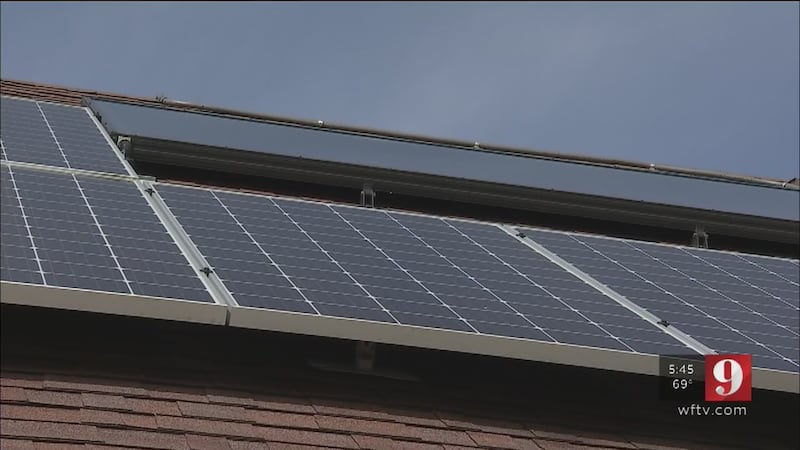LAKE COUNTY, Fla. — A Lake County man feels burned by solar energy that was supposed to almost eliminate his power bills. He claims the system produces more electricity than he can use, but he keeps getting big bills from the power company.
He called Action 9 consumer investigator Todd Ulrich for answers.
Fifty-five solar panels blanket this home's roof that Jonathan Torres owns near Clermont. “We're the Sunshine State. What better state to get sunshine than in Florida.”
Torres paid $56,000 for a system built to cover all his power needs. Its surplus is sold back to his power company SECO Energy. Torres showed us online records that documents the system produces more than he uses most days but his power bills have been a slap in the face. “It’s the consumer's problem. and unless you're willing to fight them, there's nothing they're going to do.”
His latest bills are just a little lower than months without solar. Torres estimates he's been overbilled nearly $1,500.
When he disputed that with SECO he claims the utility denied that was the case. “They will tell you every month that you're wrong no matter what data you present them.”
That's why he called Action 9. We found Florida's net metering law requires for profit utilities to pay customers for surplus power at the same rate it charges for what they use.
SECO is a nonprofit so it doesn't have to.
Solar burned! Local man spends $56,000 on solar panels but still gets big power bills. Action 9 exposes where you live makes all the difference WFTV 5:45
— Todd Ulrich (@TUlrichWFTV) December 18, 2018
The Florida Solar Energy Center part of UCF warns solar customers to review your utility’s pay back programs before installation FSEC manager John Sherwin says some consumers could be wasting money. “You really don't want to make more electricity that you need to because at that time you're selling it back to the utility at a very low rate.”
SECO told Action 9 solar customers are paid at wholesale, cheaper rates for their surplus. However, it found Jonathan Torres was overbilled for less usage and that's being corrected.
Torres just got a credit for his last bill, and SECO told Action 9 future bills will be lower. The utility said the customer turned his system on before getting proper insurance, and that had created billing confusion.
SECO provided the following statement to Channel 9:
"As a not for-profit-electric cooperative, our financial structure and rate tariffs are slightly different from those of investor-owned, profit-generating utilities. Members who interconnect to our system with individually owned systems that produce more power than their home consumes are in essence small-scale wholesale power generators. That said, we compensate those members for excess generation at the same rate that we pay our wholesale power provider Seminole Electric -- also a not-for-profit entity. SECO’s net metering policy and interconnect agreement are found in Section 16.4 of our tariff (approved by the Public Service Commission) -- and linked here for your reference.
"It is also important to note that individual members who are small-scale solar power generators in no way share in the utility’s cost of transmitting or distributing energy to another consumer who might use that excess power. They don’t share in or contribute to the costs of building, operating or maintaining the electric system or administrative costs associated with billing. Therefore, paying full retail to a member for their excess kilowatts simply doesn’t make sound financial sense and would require subsidization by other rate classes to cover the costs. Investor-owned utilities are required to pay full retail for excess generation, but they also have the profit margins to cover the skewed math. Cooperatives are not required to pay full retail as they are not-for-profit entities.
"Members who operate their own individual solar systems are not subject to any additional fees than any other member in their rate classification. The residential customer charge is 83 cents a day. SECO also offers our members free solar assessments upon request. Our trained Energy Services Specialists visit the member’s home and use a device called a Solar Pathfinder to help determine the home’s conduciveness to a rooftop or ground mount solar system. We talk to the member about system size, placement and return on investment so that they have a more accurate idea of pay back before making such a sizable investment. We also discuss insurance requirements for systems in excess of 10 kW (aligned with Florida Administrative Code). The liability insurance protects the utility’s system in the event of damage.
"In Mr. Torres’ case, he installed and energized his 19.25 kW system without submitting the proof of insurance required or the schematic plan diagram of the system’s components and connection points required by the aforementioned interconnect agreement. He energized the system without SECO’s knowledge/approval and thus without the proper metering equipment installed. This created safety and billing issues initially. Mr. Torres disagreed with the insurance requirement, it took him several months to provide proof of insurance and we found that in the meantime, he’d energized the system despite not having insurance or approval. It appears from the notes on the account that those issues are resolved but that the situation was unfortunately contentious during the process."
Cox Media Group








